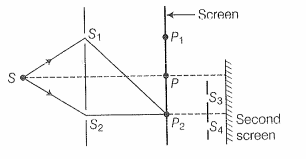Consider the diffraction pattern for a small pinhole. As the size of the hole is increased:
(a) the size decreases
(b) the intensity increases
(c) the size increases
(d) the intensity decreases
1. (a, b)
2. (a, c)
3. (b, d)
4. (c, d)
(b) the intensity increases
(c) the size increases
(d) the intensity decreases
For light diverging from a point source:
| (a) | the wavefront is spherical. |
| (b) | the intensity decreases in proportion to the distance squared. |
| (c) | the wavefront is parabolic. |
| (d) | the intensity at the wavefront does not depend on the distance. |
Choose the correct option:
| 1. | (a), (b) |
| 2. | (a), (c) |
| 3. | (b), (c) |
| 4. | (c), (d) |
Consider sunlight incident on a pinhole of width . The image of the pinhole seen on a screen shall be:
(a) a sharp white ring
(b) different from a geometrical image
(c) a diffused central spot, white in colour
(d) diffused coloured region around a sharp central white spot
1. (a, c)
2. (a, d)
3. (b, d)
4. (b, c)
Two Sources of intensity are in front of a screen [Fig.(a)]. The pattern of intensity distribution seen in the central portion is given by Fig.(b).
In this case, which of the following statements are true?
(a) have the same intensities
(b) have a constant phase difference
(c) have the same phase
(d) have the same wavelength
1. (a, b, c)
2. (a, b, d)
3. (b, c, d)
4. (c, d)
The figure shows a standard two-slit arrangement with slits are the two minima points on either side of P as shown in the figure.

At on the screen, there is a hole and behind is a second 2-slit arrangement with slits and a second screen behind them.
| 1. | There would be no interference pattern on the second screen but it would be lighted |
| 2. | The second screen would be totally dark |
| 3. | There would be a single bright point on the second screen |
| 4. | There would be a regular two-slit pattern on the second screen |
In Young's double-slit experiment, the source is white light. One of the holes is covered by a red filter and another by a blue filter. In this case,
| 1. | there shall be alternate interference patterns of red and blue |
| 2. | there shall be an interference pattern for red distinct from that for blue |
| 3. | there shall be no interference fringes |
| 4. | there shall be an interference pattern for red mixing with one for blue |
Consider a ray of light incident from the air onto a slab of glass (refractive index n) of width d, at an angle . The phase difference between the ray reflected by the top surface of the glass and the bottom surface is:
1. \(\frac{4 \pi d}{\lambda}\left(1-\frac{1}{n^2} \sin ^2 \theta\right)^{1 / 2}+\pi\)
2. \(\frac{4 \pi d}{\lambda}\left(1-\frac{1}{n^2} \sin ^2 \theta\right)^{1 / 2}\)
3. \(\frac{4 \pi d}{\lambda}\left(1-\frac{1}{n^2} \sin ^2 \theta\right)^{1 / 2}+\frac{\pi}{2}\)
4. \(\frac{4 \pi d}{\lambda}\left(1-\frac{1}{n^2} \sin ^2 \theta\right)^{1 / 2}+2\pi\)
Consider sunlight incident on a slit of width . The image seen through the slit shall
| 1. | be a fine sharp slit white in colour at the centre |
| 2. | a bright slit white at the centre diffusing to zero intensities at the edges |
| 3. | a bright slit white at the centre diffusing to regions of different colours |
| 4. | only be a diffused slit white in colour |
Consider a light beam incident from air to a glass slab at Brewster's angle as shown in the figure. A polaroid is placed in the path of the emergent ray at point \(P\) and rotated about an axis passing through the centre and perpendicular to the plane of the polaroid. Then:
| 1. | for a particular orientation, there shall be darkness as observed through the polaroid. |
| 2. | the intensity of light as seen through the polaroid shall be independent of the rotation. |
| 3. | the intensity of light as seen through the polaroid shall go through a minimum but not zero for two orientations of the polaroid. |
| 4. | the intensity of light as seen through the polaroid shall go through a minimum for four orientations of the polaroid. |


